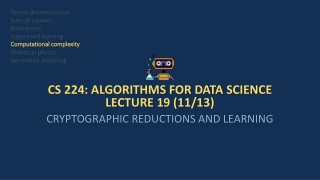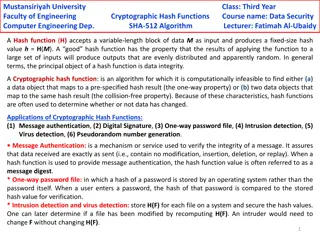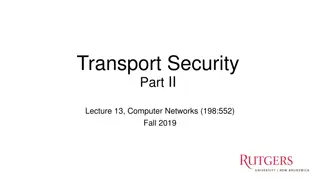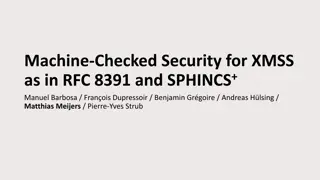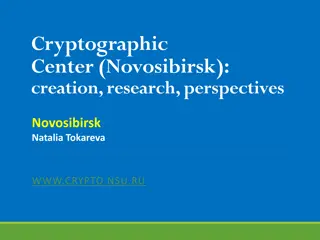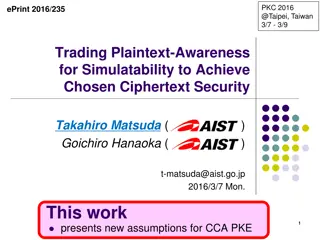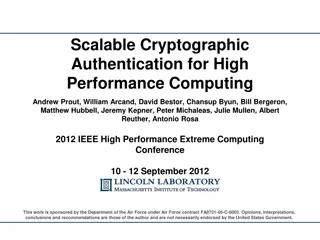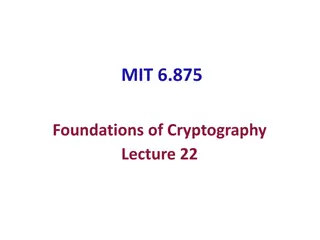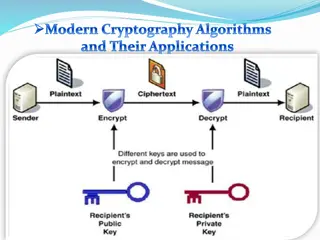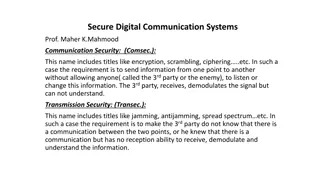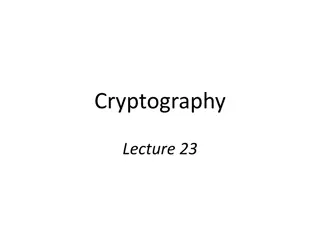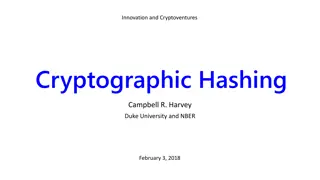Cryptographic Techniques Overview: Security in Communication
This overview delves into the realm of cryptographic techniques encompassing authentication, confidentiality, integrity, and availability for secure communication. It explores the essence of cryptography, tools for building secure channels, the great divide between symmetric and asymmetric encryption, and examples of symmetric key confidentiality.
Download Presentation

Please find below an Image/Link to download the presentation.
The content on the website is provided AS IS for your information and personal use only. It may not be sold, licensed, or shared on other websites without obtaining consent from the author.If you encounter any issues during the download, it is possible that the publisher has removed the file from their server.
You are allowed to download the files provided on this website for personal or commercial use, subject to the condition that they are used lawfully. All files are the property of their respective owners.
The content on the website is provided AS IS for your information and personal use only. It may not be sold, licensed, or shared on other websites without obtaining consent from the author.
E N D
Presentation Transcript
Security: An Overview of Cryptographic Techniques 14-736 With slides from: Debabrata Dash, Nick Feamster, Gregory Kesden, Vyas Sekar and others
Cryptography, Cryptographic Protocols and Key Distribution Authentication Mutual Authentication Private/Symmetric Keys Public Keys Key Distribution 2
What do we need for a secure communication channel? Authentication (Who am I talking to?) Confidentiality (Is my data hidden?) Integrity (Has my data been modified?) Availability (Can I reach the destination?) 3
What is cryptography? "cryptography is about communication in the presence of adversaries." - Ron Rivest cryptography is using math and other crazy tricks to approximate magic - Unknown TA 4
What is cryptography? Tools to help us build secure communication channels that provide: 1) Authentication 2) Integrity 3) Confidentiality 5
Cryptography As a Tool Using cryptography securely is not simple Designing cryptographic schemes correctly is near impossible. Today we want to give you an idea of what can be done with cryptography. Take a security course if you think you may use it in the future 6
The Great Divide Symmetric Crypto (Private key) (E.g., AES) Asymmetric Crypto (Public key) (E.g., RSA) Shared secret between parties? Yes No Speed of crypto operations Fast Slow 7
Symmetric Key: Confidentiality Motivating Example: You and a friend share a key K of L random bits, and want to secretly share message M also L bits long. Scheme: You send her the xor(M,K) and then she decrypts using xor(M,K) again. 1) Do you get the right message to your friend? 2) Can an adversary recover the message M? 3) Can adversary recover the key K? 8
Symmetric Key: Confidentiality One-time Pad (OTP) is secure but usually impactical Key is as long at the message Keys cannot be reused (why?) In practice, two types of ciphers are used that require constant length keys: Block Ciphers: Stream Ciphers: Ex: DES, AES, Blowfish Ex: RC4, A5 9
Symmetric Key: Confidentiality Stream Ciphers (ex: RC4) Pseudo-Random stream of L bits XOR Alic e: PRNG K A-B Message of Length L bits = Encrypted Ciphertext Bob uses KA-B as PRNG seed, and XORs encrypted text to get the message back (just like OTP). 10
Symmetric Key: Confidentiality Block Ciphers (ex: AES) (fixed block size, e.g. 128 bits) Block 1 Block 2 Block 3 Block 4 Round #1 Round #2 Round #n Alice: K A-B Block 1 Block 2 Block 3 Block 4 Bob breaks the ciphertext into blocks, feeds it through decryption engine using KA-B to recover the message. 11
Cryptographic Hash Functions Consistent hash(X) always yields same result One-way given Y, can t find X s.t. hash(X) = Y Collision resistant given hash(W) = Z, can t find X such that hash(X) = Z Fixed Size Hash Message of arbitrary length Hash Fn 12
Symmetric Key: Integrity Hash Message Authentication Code (HMAC) Step #1: Message Alice creates MAC Hash Fn MAC K A-B Alice Transmits Message & MAC Step #2 Step #3 Bob computes MAC with message and KA-B to verify. MAC Message Why is this secure? How do properties of a hash function help us? 13
Symmetric Key: Authentication You already know how to do this! (hint: think about how we showed integrity) I am Bob Hash Fn A43FF234 K A-B whoops! Alice receives the hash, computes a hash with KA-B , and she knows the sender is Bob 14
Symmetric Key: Authentication What if Mallory overhears the hash sent by Bob, and then replays it later? ISP D ISP B ISP C ISP A Hello, I m Bob. Here s the hash to prove it A43FF234 15
Symmetric Key: Authentication A Nonce A random bitstring used only once. Alice sends nonce to Bob as a challenge . Bob Replies with fresh MAC result. Nonce Bob Alice Nonce Hash B4FE64 K A-B B4FE64 Performs same hash with KA-B and compares results 16
Symmetric Key: Authentication A Nonce A random bitstring used only once. Alice sends nonce to Bob as a challenge . Bob Replies with fresh MAC result. ?!?! Nonce Alice Mallory If Alice sends Mallory a nonce, she cannot compute the corresponding MAC without K A-B 17
Symmetric Key Crypto Review Confidentiality: Stream & Block Ciphers Integrity: HMAC Authentication: HMAC and Nonce Questions?? Are we done? Not Really: 1) Number of keys scales as O(n2) 2) How to securely share keys in the first place? 18
Asymmetric Key Crypto: Instead of shared keys, each person has a key pair KB Bob s public key KB-1 Bob s private key The keys are inverses, so: KB-1(KB (m)) = m 19
Asymmetric Key Crypto: It is believed to be computationally unfeasible to derive KB-1 from KB or to find any way to get M from KB(M) other than using KB-1 . => KB can safely be made public. Note: We will not explain the computation that KB(m) entails, but rather treat these functions as black boxes with the desired properties. 20
Asymmetric Key: Confidentiality Bob s public key KB Bob s private key KB-1 encryption algorithm decryption algorithm plaintext message ciphertext KB (m) m = KB-1(KB (m)) 21
Asymmetric Key: Sign & Verify If we are given a message M, and a value S such that KB(S) = M, what can we conclude? The message must be from Bob, because it must be the case that S = KB-1(M), and only Bob has KB-1 ! This gives us two primitives: Sign (M) = KB-1(M) = Signature S Verify (S, M) = test( KB(S) == M ) 22
Asymmetric Key Review: Confidentiality: Encrypt with Public Key of Receiver Integrity: Sign message with private key of the sender Authentication: Entity being authenticated signs a nonce with private key, signature is then verified with the public key But, these operations are computationally expensive* 23
Biometrics Nice in some respects No need to distribute Reducible to digital form Unique in practice Hard to duplicate? Used via binary representation Warm gelatin fingers or slip-on finger-pads molded to prints? Artificial eyeballs made to match scans? Pictures? Videos w/blinking? Change over time? Injury? Aging? Not replaceable or revocable What happens when stolen? Are you Deleted ?!?!? (Well, you do have 10 fingers, two retinas, one nose, etc) 24
Multi-Factor, Human Factors Best systems use more than one factor Something you know Something piece of you Biometrics + Password/Q&A Challenge, Etc More natural factors better than fewer unnatural challenges More weak factors may be stronger than fewer stronger factors Human factors are critical Too many password restrictions? Too many passwords? Write them down on Post-Its Notes! 25
Summary Symmetric (pre-shared key, fast) and asymmetric (key pairs, slow) primitives provide: Confidentiality Integrity Authentication Hybrid Encryption leverages strengths of both. Great complexity exists in securely acquiring keys. Crypto is hard to get right, so use tools from others, don t design your own (e.g. TLS). 26
Introduction to Blockchains John Kelsey,NIST https://csrc.nist.gov/csrc/media/projects/supply-chain-risk- management/documents/ssca/2016-fall/wed_am2- block_chain_john_kelsey.pdf
Overview Prologue: A chess-by-mail analogy What problem does a blockchain solve? How do they work? Hash chains Deciding what blocks are valid on the chain Deciding whether we have the current chain Permissioned blockchains, proof of work, etc. Wrapup
Warm-up: Alice and Bob want to play chess by mail Alice sends Bob 1 e4 Bob sends back 1 ... e5 Alice sends Bob 2 Nf3 ... Each of these messages is one move in the game What s necessary for them to be able to play the game?
They have to agree on the state of the board If they don t agree on the state of the board, they can t play a game! 1. Both know the starting positions of the board. 2. Both know the sequence of messages so far. Those messages make up a transcript of the game. 3. Thus, they can reconstruct the state of the board. If we agree on history, we agree on the present state of the world!
Whats that got to do with blockchain? We have some distributed system We need to all agree on the state of some system We all agree on the initial state of the system A blockchain contains a history of individual transactions Thus: We can all agree on the current state of the system A blockchain lets mutually-distrusting entities agree on history... ...which lets them agree on the state of the system now.
Why is this important? Example: Bitcoin Suppose I want to transfer 100 BTC to you. You need to know whether my account has 100 BTC in it. For that, you need to know the current state of the system. Note: You need to know the current state If you re looking at an old state of the system, I might be paying you with money I ve already spent!
What problem does a blockchain solve? A blockchain lets us agree on the state of the system, even if we don t all trust each other! Ultimate goal: We all need to agree on the state of some system. How much BTC in each account? Who owns which property? What s the current state of my program? We can all agree on that if we agree on history. Starting state + history current state We don t want a single trusted arbiter of the state of the world. We want some level of decentralization not a single point of failure or compromise.
Trusted Arbiter If we had a completely trusted arbiter, we wouldn t need a blockchain! We could just define reality as whatever TA said it was. For a payment system, imagine TA as the bank Bank provides the official sequence of transactions and account balances When you want to spend your money, you send a message to bank Bank permits transaction if you have money, and updates account balances.
Why not just have a trusted arbiter, then? 1. Single point of failure If the TA goes down for a week, the system stops working! 2. Concentration of power He who controls the past, controls the future TA can censor transactions, impose new conditions to get transactions included in history, etc. 3. Maybe there s nobody we all trust
So what does a blockchain buy us, again? Distributedsystem We don t all trust each other or any single entity We want to agree on history ...so we can agree on the state of our system... ...so we can do something. We get the functionality of a trusted arbiter... ...without needing a trusted arbiter
How does it work? A blockchain is a sequence of hash-chained records Once you ve seen record N, you can t change anything in the past. Some procedure for adding blocks to blockchain Who gets to add blocks? How is it done? Validity conditions for new blocks Are transactionsvalid? Are digital signatures correct? Etc. Enforced by consensus- chains with invalid blocks won t be accepted. Some procedure for deciding between alternative candidate blockchains. When Alice and Bob have different pictures of history, there s some way for them to eventually come to agreement about who is right.
Building Block: Cryptographic hash functions A cryptographic hash function: Takes any bitstring as an input* (Like a 10 MB file) Produces a fixed-length output (Typically 256 or 512 bits) Nobody can find collisions. Examples: SHA256, SHA512, SHA3-256, RIPEMD-160 * Sometimes there s a (really huge) maximum input length.
Whats a collision? Suppose I can find two different inputs X and Y so that Hash(X) = Hash(Y) That s a collision. For a cryptographic hash function to be any good, it needs to be collision-resistant. That just means it s impossible in practice to find colliding inputs.
Why is collision resistance useful? If nobody can find X != Y such that Hash(X) == Hash(Y), ...then we can use hash(X) as a kind of message digest of X. Digital signatures actually sign hash(message) instead ofmessage. Nobody can change X without changing hash(X) If they could do that, they can find collisions forhash() hash(X) also commits to X. Once I ve seen hash(X), later, you can show me X, and I ll know it s the value you committed to ...you can t show me some other X*, because it won t have the same hash.
Building block: Hash chains Figure: A sequence of records linked together; each record contains the hash of the previous record.
Whats a hash chain? A hash chain is a sequence of records in which each record contains the hash of the previous record in the chain, and the hash of all the current record s contents. Figure: A sequence of records linked together; each record contains the hash of the previous record.
What does that buy us? We re using a cryptographic hash function like SHA256. That means nobody can find two inputs with the same hash value. ...and that means that record N contains a commitment to record N-1 ...which contains a commitment to record N-2, which contains a commitment to record N-3, and so on. Figure: A sequence of records linked together; each record contains the hash of the previous record.
Hash chains and block chains Hash chains have the property that every record contains a commitment to all previous records. If you change record N, this changes the final hashes of records N+1, N+2, ... Result: Once we all accept record N, we have locked in the contents of record 1, 2, 3, ..., N-1 as well. Blockchains use hash chains as a component Hash chains are also useful in a lot of other contexts For example, a system with a trusted arbiter can use a hash chain to limit the arbiter s power even the arbiter can t change history.
The block chain Hash10 Hash11 Hash12 ... ... H H H H Nonce11 Nonce12 Nonce13 Trans Trans Trans 11 12 13 Figure: A block chain containing three blocks, each containing the hash of the previous block, and each containing a sequence of transactions and a nonce. Each block in the chain commits to all previous blocks and transactions
Building Block: Validity conditions What will the world accept as the nextblock? We don t have some trusted entity to decide what may be added to block chain ...so we have to decide what blocks are valid. Example: Bitcoin Signatures needed for moving BTC from an account Not allowed to leave a negative balance in an account Block must contain correct proof-of-work A proposed additional block that doesn t meet these conditions won t be accepted by the rest of thenetwork. Enforced by consensus
Forked chains Blockchains are used in distributed systems It s possible for different parties in the system to have a disagreement There s no trusted arbiter to decide who is right! Any blockchain must deal with this issue somehow! Suppose Alice and Bob no longer agree on the state of the world (because they don t agree on history) How do they come to an agreement on who s right? Several different techniques to resolve disagreements
Adding new blocks to the chain Any blockchain system has to determine who can add new blocks to the chain, and how it s done. Two main ideas I ll discuss below Proof of work Permissioned blockchain Also more ideas I m not going to talk about Proof of stake Proof of storage Probably several more I ve never heard of
Building Block: Proof of Work I want you to do a big computation. I want you to prove you did it. I don't want to do much work checking the proof. Why is this useful? Limits the rate of new blocks Makes attempts to add invalid blocks to the chain expensive Provides a clear way to decide between competing chains when there is a disagreement the one with the most work wins. Note: Not all blockchains use proof of work
Hash-based proof of work I give you challenge C and limit L = 2220. Ask you to find N such that SHA256(C||N) < L Expected work = 236 Each new N has prob 2-36 of success When you succeed, only takes me one hash to check. This is more-or-less Adam Back's hashcash scheme


